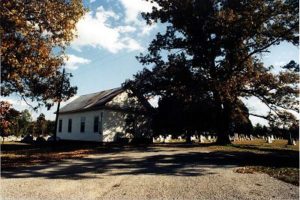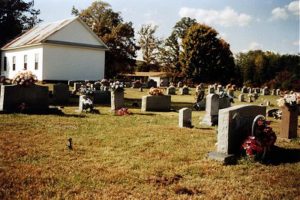Mt. Pisgah Methodist Church
The early part of this historical sketch is based on the historical articles by L.L. McDowell, Dr. C.S. “Kit” Rascoe and other data compiled by Miss Gertrude Saylors. It has been brought up to date in 1969 by Mrs. John A. (Mildred Sims) Horton.
To find Mt. Pisgah M.E.Church, the place that became Mt. Pisgah, traveling north from Warren County, begin at the once famous fording of the Caney Fork River, near Rock Island. This is where the Chicamauga path of the Red Man broke through one of the barriers of the Pisgah district, which was settled in the early days, even though shut in by a mountain range and this impassable river. Cross the high bridge on the smooth modern highway, pass the monument commemorating the last stand of the native Indians in the “Battle of Rock Island”and you come, shortly, to the village of Walling. Turn left. You are now on a famous pioneer trail. It is still called by its time-honored name, the Old Kentucky Road. At the sharp left turn on this road, about 3 miles north of Walling, you turn right; drive a few rods and there you see, in a grove of large oak trees, the third “meeting” house called Mt. Pisgah, just beyond it you see the large and old burial ground shaded by many old cedars, the first grave being dug in 1808.
The Methodist Church was organized here in 1820. 
School, perhaps in the homes of pioneers, was being taught for this community before the church was organized. For according to the lichen-covered headstone with rough-hewn circular top, one may read “Rosey Hutson”, born 1787-died 1817. Teachers for schools in the wilderness in those days, were hard to come by. But, it is said by Rosey’s kinsmen, that she came to White County, riding horseback with a group from North Carolina, to teach (for a time), not to remain permanently. It is believed she fell victim to typhoid, as did other pioneer users of spring water. The Hutsons and Knowles being intermarried, she was buried in the burying ground, selected by John Knowles, Sr. for his son-in-law, Archibald McDaniel, husband of Elizabeth Knowles.
Although the church was not organized until 1820, we have cause to believe worship in the community was being conducted much earlier, perhaps in the homes and almost certainly in arbor meetings.
It is likely that Bishop Asbury, not a bishop at the time of his coming, sent to American by John Wesley, preached to arbor crowds at Pisgah. If not, we do know by the many “Asbury” namesakes he rated in this community, that his influence here was great. Of course, we know he did not preach in the first church building, having died four years before the church was organized.
“About 1826, the Camp Ground was moved from the Keathley Old Camp Ground to this place. A large arbor was built about the center of the campus where services were held. Annually, on the 4th Saturday in August, the Methodists would move their families here and go into Camp, and stay a week or 10 days (some in covered wagons, others were entertained in local homes, and still others stayed in cabins that had been previously prepared). Yes, I have heard the conch shell blown many times to call the people to the arbor services. The last one of these old Camp meetings was held here just 49 years ago.”
“In the early 1840s there was a Sunday School organized here by Charles and William Bosson. It was the first Sunday School ever organized in White County. There were something like 250 pupils in attendance at this school. It was my good fortune to be one of the pupils of that Sunday School.”
Of the five preachers who went out from Pisgah, there were Rev. Thomas E. Hutson-Hudson, Rev. Peter Buram, Joseph Knowles, Rev. Jeremiah Webb and Fred Hembree. (At the present time, 1969, young Fred Hembree is pastoring the Woodbine United Methodist Church in Nashville, Tennessee.)
Mt. Pisgah Church Building # one. This building was small and made of logs. It was burned, together with the Camp Meeting cabins on the church campus by Yankee soldiers in 1861-1865.
Mt. Pisgah Church Building #two. (From a Sparta Newspaper article, published about 1930, written 1909, by Dr. C.S. “Kit” Rascoe.) Quote: “During the days of Reconstruction, when times were the hardest I ever saw, a few of the members of the church and neighbors rebuilt the church.” ( It was larger that the first one, but was also made of logs furnished with rough seats.) “Now, the house needs to be moved out of the cemetery and a new house built in a different place.”
Source:
This article was originally published in “The Sparta Expositor” on July 10, 1969.
Contributed by Jane Hembree Crowley
